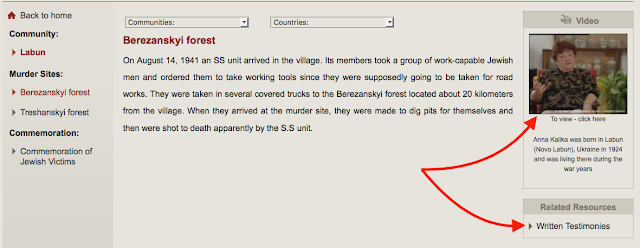And I'm shocked - shocked!
I am shocked not only because the stories of what happened during the Shoah in my family's communities is horrifying and heart-breaking;
I am shocked not only because I pride myself on knowing about the resources of my craft: Jewish genealogy - and somehow missed this one; but also,
I am shocked because locating this important information on the Yad Vashem website is difficult - very difficult.
 |
| Two clicks to the "Shoah Names Database" |
On another website, I'd found a URL link to the "Untold Stories" part of the the Yad Vashem website and was enthralled. This is the kind of information that Father Patrick DuBois has been collecting in his Yahad in Unum (Holocaust By Bullets) project. [Unfortunately, he has a huge workload ahead of him and the towns of interest to me have not yet been visited.] I tried to locate the "Untold Stories" page on Yad Vashem by navigating via the tabs on the website. This was quite the challenge. Ultimately I located it by clicking on:
- the Research tab
- Projects
- Killing Sites
- The Untold Stories: The Murder Sites of the Jews in the Occupied Territories of the Former USSR
- Online Guide of Murder Sites of Jews in the Former USSR
I already have acquired permission to use the image of the Labun bath house from the American Jewish Joint Distribution Committee's Archives website on my Labun/Yurovshchina community website. But I had not before seen the fuzzy image, attributed to the University of Southern California Shoah Foundation Archives, of other town buildings.[2] The photograph shows a church that is not extant in Labun today. I will have to do some additional study of the photos I took when in Labun/Yurovshchina in June 2013, but I think this church must have stood in the grassy expanse of the former market area.
When one clicks on one of the murder sites, one also gains access to links to video and written testimony about the atrocities.
In the case of Labun, Yad Vashem only has a photo of one of the memorial monuments - and a poor one, at that. I took photographs here and here of both memorials and will see if Yad Vashem would like copies of those images.
For some reason Labun is not listed in this table. However, I was able to locate sites in other nearby communities: Polonnoye, Gritsev, and Baranovka. In other regions, such as Wolyn, I found information about Annopol, near Slavuta.
Check this out for your ancestral community. This is a wonderful resource. I just wish it were not so hidden on the Yad Vashem website!
Notes:
1. For those, who are not as familiar with the Yad Vashem website as they should be, the "Shoah Names Database" holds an ever-expanding index of records (and, in some case, digitized original documents) of those who were victims of the Holocaust. It includes "Pages of Testimony" submitted since about 1956 by people reporting information about family and friends who died in the Shoah, as well as documentation Yad Vashem has collected from other sources.
2. I have requested permission to use this photo on my Labun/Yurovshchina community website, but have yet to hear back from the Shoah Foundation.






No comments:
Post a Comment
Comments on posts are always welcome but will be approved before posting. I actually prefer to just let people comment without going through this rigmarole, but I've recently had to delete some posts that I had not vetted before publication. So, please don't be offended. I love to hear from you!